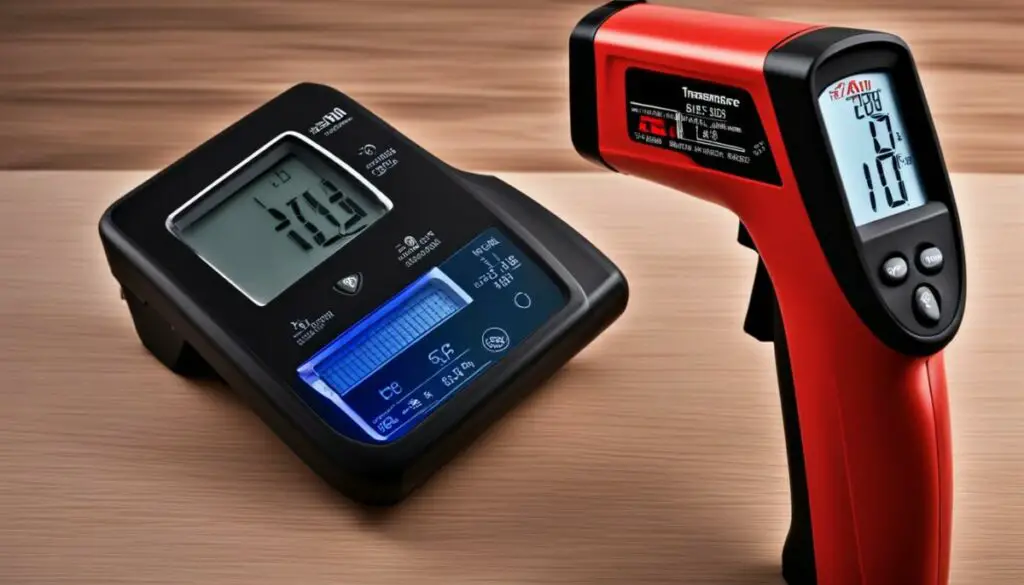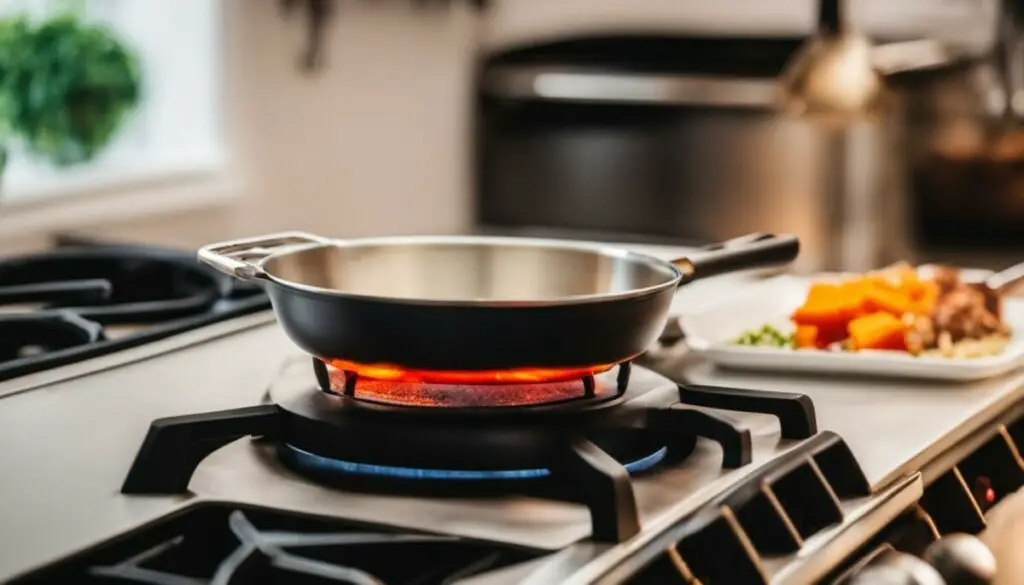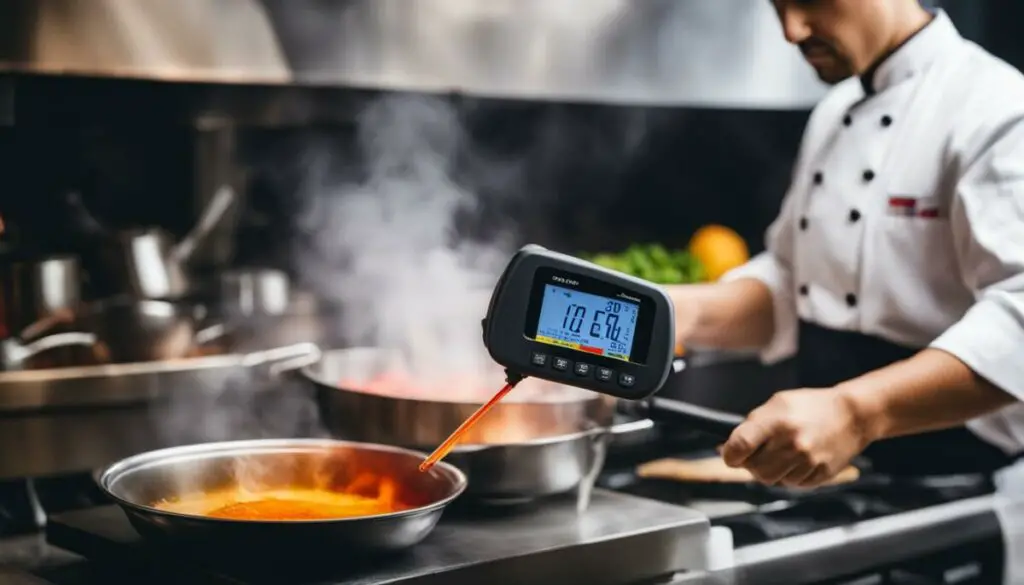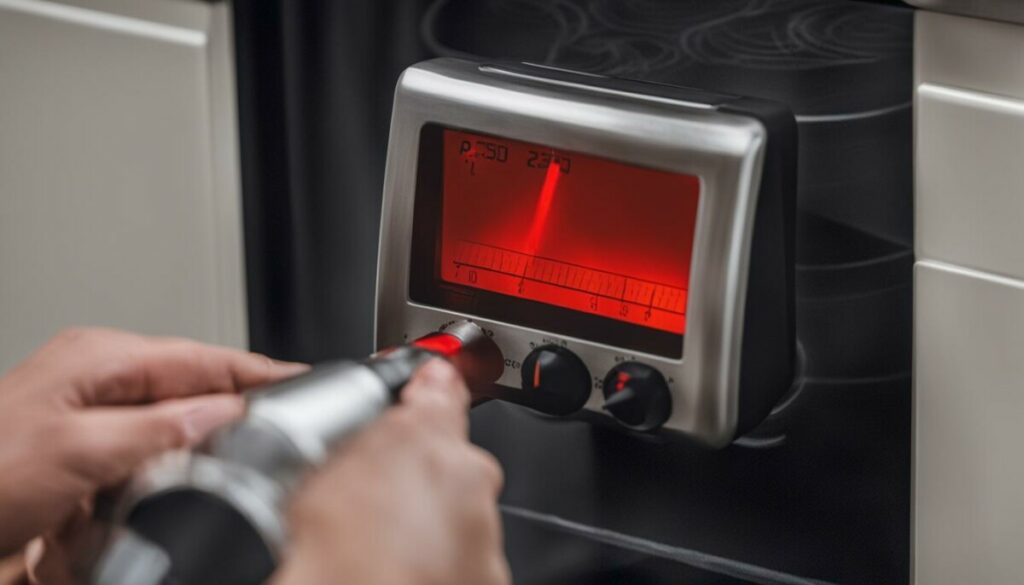Last Updated on 5 months by Francis
Are infrared thermometers good for cooking? If you’ve ever wondered about the benefits of using infrared thermometers in the kitchen, you’re in the right place. Infrared thermometers have become a favorite tool for both professional and home cooks alike, thanks to their accuracy and safety.
So, what makes infrared thermometers so good for cooking? These handy devices measure temperatures by detecting the infrared light emitted by objects. This makes them perfect for measuring oven and food temperatures without being exposed to high heat. Let’s dive deeper into the world of infrared thermometers and explore why they are an ideal tool for cooking.
Contents
Key Takeaways:
- Infrared thermometers are a favorite tool for professional and home cooks due to their accuracy and safety.
- They measure temperatures by detecting infrared light emitted by objects, making them perfect for measuring oven and food temperatures.
- Infrared thermometers are ideal for cooking pizza, as they can measure high temperatures accurately and safely.
- Using an infrared thermometer for cooking is simple – just point, pull the trigger, and get instant temperature readings.
- In addition to cooking, infrared thermometers have other uses, such as measuring fridge temperatures and body temperatures.
What Is an Infrared Thermometer?

An infrared thermometer is a versatile and accurate tool used for measuring temperatures in various applications. It works by detecting infrared light emitted by objects and converting it into a temperature reading. By using a built-in lens, the infrared thermometer concentrates the infrared light onto a detector known as a thermopile, which then calculates the temperature.
Unlike traditional thermometers that require physical contact with the object being measured, infrared thermometers offer a non-contact method, making them ideal for cooking and other situations where direct contact may not be possible or desirable.
Infrared thermometers are used in a wide range of industries, from cooking to automotive maintenance. They provide quick and reliable temperature measurements, making them an essential tool for professionals and home users alike. By simply pointing the thermometer at the object, pulling the trigger, and reading the temperature displayed on the screen, you can easily and accurately measure the temperature of ovens, grills, cookware, and more.
Infrared Thermometer Components
Understanding the key components of an infrared thermometer can help you appreciate its functionality. Some of the important components include:
- Optics: The built-in lens focuses the infrared light onto the thermopile, ensuring accurate readings.
- Thermopile: The thermopile converts the infrared energy into an electrical signal, which is then processed to calculate the temperature.
- Digital Display: The temperature is displayed on a digital screen for easy reading.
- Emissivity Setting: Some infrared thermometers allow you to adjust the emissivity setting to account for different materials and surfaces.
| Component | Description |
|---|---|
| Optics | The lens focuses the infrared light onto the thermopile. |
| Thermopile | Converts infrared energy into an electrical signal for temperature calculation. |
| Digital Display | Shows the temperature readings on a clear screen. |
| Emissivity Setting | Allows adjustments for different materials and surfaces. |
“Infrared thermometers provide quick and reliable temperature measurements, making them an essential tool for professionals and home users alike.”
Why Are Infrared Thermometers Ideal for Cooking Pizza?

Infrared thermometers are a game-changer when it comes to cooking pizza. Whether you’re a professional chef or a home cook, using an infrared thermometer can elevate your pizza-making skills to new heights. Here’s why:
Accuracy: Infrared thermometers provide precise temperature measurements, allowing you to ensure that your pizza crust is perfectly cooked. By measuring the surface temperature of both the oven and the pizza, you can achieve the ideal balance between a crispy crust and a gooey, melted cheese topping.
Safety: Cooking pizzas often involves working with high temperatures, which can pose a risk of burns or undercooking. With an infrared thermometer, you can measure the temperature without exposing yourself to direct heat, minimizing the chances of accidents and ensuring that your pizza is cooked to perfection.
Versatility: Infrared thermometers aren’t just limited to measuring oven temperatures. They can also be used to monitor the surface temperature of pizza stones, grills, and cookware. This versatility allows you to experiment with different cooking methods and achieve consistent results every time.
Table: Comparing Infrared Thermometers to Other Cooking Thermometers
| Infrared Thermometer | Traditional Probe Thermometer | Thermocouple Thermometer | |
|---|---|---|---|
| Temperature Range | Wide range, up to 986°F | Limited range, typically up to 500°F | Wide range, up to 3000°F |
| Measurement Speed | Instantaneous | Slower, requires inserting the probe and waiting for a reading | Instantaneous |
| Non-Contact Measurement | Yes | No | No |
| Portability | Compact and handheld | Requires a separate probe and display unit | Compact and handheld |
As you can see from the table, infrared thermometers offer a wide temperature range, rapid measurement speed, and the convenience of non-contact temperature measurement. These features make them an excellent choice for cooking pizza and other culinary endeavors.
So, whether you’re a pizza enthusiast or a professional pizzaiolo, consider adding an infrared thermometer to your kitchen arsenal. Its accuracy, safety, and versatility will take your pizza-making skills to the next level.
Using an Infrared Thermometer for Cooking

An infrared thermometer is a valuable tool for temperature control when cooking. Its non-contact measurement method makes it safe and convenient to use in the kitchen. Whether you’re measuring the temperature of your oven, grill, or cookware, an infrared thermometer provides instant and accurate readings.
Temperature Control Made Easy
Using an infrared thermometer for cooking is simple and straightforward. Just point the thermometer at the object you want to measure, pull the trigger, and the temperature will be instantly displayed on the screen. This makes it easy to monitor the temperature of your oven or grill, ensuring that your food is cooked to perfection.
Additionally, an infrared thermometer can be used to measure the temperature of your cookware before adding ingredients. This is especially useful for recipes that require precise temperature control, such as candy-making or tempering chocolate. By accurately measuring the temperature of your cookware, you can achieve the desired results every time.
Benefits of an Infrared Thermometer
Using an infrared thermometer for cooking offers several benefits. Firstly, it allows you to accurately measure the temperature without the need for direct contact, reducing the risk of burns or cross-contamination. Secondly, the instant temperature readings help you save time and make adjustments as needed during the cooking process. Lastly, an infrared thermometer provides consistent and reliable results, ensuring that your dishes turn out perfectly cooked.
With its ease of use and reliable performance, an infrared thermometer is a must-have tool for any cooking enthusiast. Whether you’re a home cook or a professional chef, using an infrared thermometer can greatly enhance your culinary skills and precision in the kitchen.
Advantages of Using Infrared Thermometers for Cooking
When it comes to cooking, infrared thermometers offer a range of advantages that make them a valuable tool in the kitchen. Whether you’re a professional chef or a home cook, these thermometers can enhance your cooking experience and ensure that your dishes are cooked to perfection.
One of the key advantages of using infrared thermometers for cooking is their ability to accurately measure surface temperatures. This is especially useful when cooking delicate foods like pizza, where getting the temperature just right can make all the difference. With an infrared thermometer, you can easily measure the temperature of both the oven and the surface of the food, ensuring that your pizza crust is perfectly crisp and evenly cooked.
Another advantage of infrared thermometers is their non-contact measurement capability. Unlike traditional thermometers that require physical contact with the food, infrared thermometers can measure temperature from a distance. This means you can easily check the temperature of a hot pan, grill, or even a boiling pot of water without the risk of getting burned.
Additionally, infrared thermometers offer quick and instant temperature readings. With just a simple pull of the trigger, you can get an accurate temperature reading in seconds. This makes them not only convenient but also time-saving, allowing you to monitor and adjust temperatures with ease.
| Advantages of Using Infrared Thermometers for Cooking |
|---|
| Accurately measures surface temperatures |
| Non-contact measurement for safety |
| Quick and instant temperature readings |
With all these advantages, it’s no wonder that infrared thermometers have become a must-have tool for many cooks. Whether you’re baking, grilling, or cooking on the stovetop, having an infrared thermometer at your disposal can help you achieve consistent and delicious results every time.
Browsing for the Perfect Infrared Thermometer
Choosing the best infrared thermometer for cooking can seem overwhelming with the wide range of options available. To make an informed decision, consider the following factors:
Temperature Range:
Ensure that the infrared thermometer you choose has a wide temperature range suitable for cooking. Look for a thermometer that can measure high temperatures, up to at least 600 degrees Fahrenheit, to cover various cooking methods.
Durability:
Since cooking often involves high heat and potential drops or accidents, it’s essential to select a thermometer that is built to withstand rugged environments. Opt for a model with a sturdy construction and durable materials to ensure it can handle the demands of your kitchen.
Accuracy:
Accuracy is crucial when it comes to measuring temperatures in cooking. Look for an infrared thermometer with a high level of accuracy, preferably within ±1% or ±1-degree tolerance. This will ensure precise temperature measurements and reliable cooking results.
By considering these factors, you can find the perfect infrared thermometer for your cooking needs. Remember to read customer reviews and compare different models to make an informed decision. Don’t forget to take note of the warranty and customer support offered by the manufacturer to ensure a hassle-free experience with your new thermometer.
| Feature | Consideration |
|---|---|
| Temperature Range | Wide range, at least 600°F |
| Durability | Sturdy construction and durable materials |
| Accuracy | ±1% or ±1-degree tolerance |
| Customer Reviews | Read and compare different models |
| Warranty and Customer Support | Ensure a hassle-free experience |
High-Temperature Pizza Ovens: The Ultimate Upgrade

Cooking pizza in a high-temperature oven adds a new dimension to the flavor and texture of the crust. But how do you ensure that your oven is at the optimal temperature for the perfect pizza? That’s where an infrared thermometer for grilling and oven cooking comes in handy.
An infrared thermometer allows you to precisely measure the temperature of your pizza oven, ensuring that it reaches the desired heat level. With the ability to measure temperatures up to 900 degrees Fahrenheit, an infrared thermometer takes the guesswork out of achieving the ideal cooking environment for your pizza.
By using an infrared thermometer, you can monitor the temperature fluctuations inside the oven and make necessary adjustments to achieve consistent cooking results. Whether you prefer a crispy, thin crust or a chewy, Neapolitan-style pizza, an infrared thermometer helps you maintain precise control over the cooking process, resulting in a delicious pizza every time.
So, why settle for a regular oven when you can upgrade to a high-temperature pizza oven and take your pizza-making skills to the next level? With the help of an infrared thermometer, you can ensure that your oven is operating at the perfect temperature for a truly exceptional pizza experience.
The Benefits of Using Infrared Thermometers for Cooking

If you’re an avid cook or a professional chef, using an infrared thermometer can bring numerous benefits to your culinary endeavors. Infrared thermometers offer exceptional accuracy and safety when measuring temperatures, making them an indispensable tool in the kitchen. Whether you’re cooking pizza, checking oven temperatures, or ensuring food safety, these thermometers are a game-changer.
One of the key benefits of using infrared thermometers for cooking is their accuracy. These devices can measure temperatures with pinpoint precision, providing you with accurate readings within seconds. This allows you to ensure that your food is cooked to perfection, eliminating the risk of undercooking or overcooking.
Another advantage is the safety they offer. With infrared thermometers, you can measure temperatures without direct contact with the hot object or surface. This significantly reduces the risk of burns or accidents in the kitchen, making them a preferred choice for both professionals and home cooks.
Using an infrared thermometer for cooking is simple and hassle-free. Just point the device at the object or surface you want to measure, pull the trigger, and the temperature will be instantly displayed on the screen. It’s a convenient and efficient way to ensure that your food is cooked at the right temperature.
From measuring oven and grill temperatures to spot-checking the holding temperatures of plated foods, infrared thermometers have multiple applications in the kitchen. They can also be used for measuring the temperature of cookware, ensuring that it’s at the optimal heat for various cooking techniques. With their versatility and accuracy, infrared thermometers are a valuable tool for any cooking enthusiast or professional chef.
Table: Comparing the Benefits of Infrared Thermometers for Cooking
| Benefits | Explanation |
|---|---|
| Accuracy | Infrared thermometers provide precise temperature measurements, ensuring perfectly cooked food. |
| Safety | These thermometers allow temperature measurement without direct contact, reducing the risk of burns. |
| Convenience | Easy to use, providing instant temperature readings with a simple point and trigger mechanism. |
| Versatility | Infrared thermometers can be used for various applications in the kitchen, from measuring oven temperatures to checking the temperature of cookware. |
The Versatility of Infrared Thermometers in Various Industries

Infrared thermometers are incredibly versatile tools that find applications in various industries for temperature control. Their ability to measure surface temperatures quickly and accurately makes them indispensable in retail, service stations, garages, logistics, and industrial settings.
One of the key advantages of infrared thermometers is their non-contact measurement capability. This feature enables workers to take temperature readings from a safe distance, minimizing the risk of burns or injuries. In industrial settings, infrared thermometers are commonly used to monitor the temperature of machinery, motors, and electrical components, helping identify potential issues before they become major problems.
Furthermore, infrared thermometers are also used in industries that require precise temperature control, such as food processing and pharmaceutical manufacturing. By accurately measuring the temperature of critical points in the production process, infrared thermometers ensure compliance with safety regulations and quality standards.
The versatility of infrared thermometers extends beyond temperature control. They are also used in industries where thermal imaging is crucial, such as building inspection, energy auditing, and HVAC troubleshooting. By detecting temperature variations and anomalies, infrared thermometers help professionals identify energy inefficiencies, insulation gaps, and potential equipment malfunctions.
Table: Applications of Infrared Thermometers in Various Industries
| Industry | Application |
|---|---|
| Food Processing | Monitoring cooking, cooling, and storage temperatures |
| Pharmaceutical Manufacturing | Ensuring proper temperature control during production |
| Building Inspection | Detecting energy inefficiencies and insulation gaps |
| Energy Auditing | Identifying areas of heat loss and energy wastage |
| HVAC Troubleshooting | Locating air leaks and diagnosing system malfunctions |
Infrared thermometers are invaluable tools in industries that require temperature control and thermal imaging. Their non-contact measurement capability and accuracy make them ideal for various applications, from monitoring machinery in industrial settings to identifying energy inefficiencies in buildings. With their versatility and reliability, infrared thermometers continue to play a crucial role in ensuring safety, efficiency, and quality across different industries.
Understanding the Operating Principles of Infrared Thermometers

Infrared thermometers are innovative devices that rely on sophisticated technology to measure temperature accurately. By understanding the operating principles of these thermometers, you can harness their full potential and make precise temperature measurements in various applications.
At the heart of an infrared thermometer is a thermopile detector that detects infrared energy emitted by objects. When the thermometer is pointed at an object, it collects the emitted energy and translates it into temperature readings. The accuracy of the measurements is influenced by factors like the distance-to-spot size ratio and the emissivity of the object.
The distance-to-spot size ratio is an important consideration when using an infrared thermometer. It determines the size of the area or spot being measured in relation to the distance from the object. A smaller spot size allows for more accurate temperature readings, especially when measuring smaller objects or areas. On the other hand, a larger spot size may be suitable for measuring larger objects or areas but may result in less precise readings.
Emissivity refers to an object’s ability to emit infrared energy. Each object has a unique emissivity value that can affect the accuracy of temperature measurements. It is crucial to understand the emissivity values of the objects you are measuring and adjust the thermometer accordingly for accurate results. Some infrared thermometers offer adjustable emissivity settings to accommodate different objects.
Advantages of Infrared Thermometers
- Non-contact measurement: Infrared thermometers allow for temperature measurement without direct contact with the object, ensuring safety and preventing cross-contamination.
- Quick and convenient: With just a press of a button, infrared thermometers provide instant temperature readings, making them efficient for fast-paced environments.
- Versatility: Infrared thermometers can be used for a wide range of applications, including cooking, HVAC systems, electrical inspections, and automotive diagnostics.
- Accuracy: When used correctly and considering the operating principles, infrared thermometers can provide accurate temperature measurements in various situations.
“Infrared thermometers are reliable tools for measuring temperatures without direct contact, making them essential in many industries. Understanding the operating principles of these thermometers helps ensure accurate and efficient temperature measurements.” – Anonymous
Proper Use and Limitations of Infrared Thermometers
When using an infrared thermometer for cooking, it’s important to understand its proper use and limitations to ensure accurate temperature measurements. While these thermometers offer many benefits, they also have some considerations that users should be aware of.
Firstly, it’s essential to avoid measuring temperatures through glass or plastic surfaces, as these materials can interfere with the accuracy of the readings. Infrared thermometers work by detecting infrared energy emitted by objects, and glass or plastic can affect the transmission of this energy, leading to inaccurate results.
Additionally, certain environmental factors can also impact the accuracy of infrared thermometers. Dust, smoke, fog, or steam can interfere with the measurement process, causing erroneous temperature readings. It’s important to be cautious when using these thermometers in such conditions and to ensure that the measurement area is clear from any potential interference.
Furthermore, it’s crucial to keep in mind that infrared thermometers can only measure surface temperatures and not internal temperatures. They are designed to detect the infrared light emitted by objects, which is directly related to the surface temperature. Therefore, when using an infrared thermometer for cooking, it’s important to understand that it provides information about the temperature on the surface of food or objects and not about the internal temperature.
By following these guidelines and understanding the limitations of infrared thermometers, users can achieve accurate temperature measurements in their cooking endeavors. When used properly, these thermometers are valuable tools for ensuring food safety and achieving precise cooking results.
Proper Use of Infrared Thermometers:
- Avoid measuring temperatures through glass or plastic surfaces.
- Take caution when measuring in conditions with dust, smoke, fog, or steam.
Limitations of Infrared Thermometers:
- They can only measure surface temperatures, not internal temperatures.
Understanding these considerations will help users harness the accuracy and benefits of infrared thermometers in their cooking practices.
Conclusion
Infrared thermometers prove to be an excellent choice for cooking enthusiasts, offering accurate temperature measurements without the need for direct contact with hot objects. Whether you’re cooking pizza, measuring oven and grill temperatures, or ensuring food safety, these versatile tools have got you covered.
By understanding the operating principles and limitations of infrared thermometers, you can fully harness their potential in the kitchen. Remember to avoid measuring temperatures through glass or plastic, and be mindful of potential interference from dust, smoke, fog, or steam.
With their ability to measure surface temperatures quickly and accurately, infrared thermometers are a valuable addition to any cook’s arsenal. So, why not upgrade your cooking experience with the convenience and precision of infrared technology? Get yourself an infrared thermometer and take your cooking to new heights!
FAQ
Are infrared thermometers good for cooking?
Yes, infrared thermometers are excellent tools for cooking. They provide accurate temperature measurements without the need for direct contact with hot objects, making them safe and convenient to use in the kitchen.
What is an infrared thermometer?
An infrared thermometer is a device that measures temperature by detecting infrared light emitted by objects. It uses a built-in lens to concentrate the infrared light onto a detector known as a thermopile, providing accurate temperature readings.
Why are infrared thermometers ideal for cooking pizza?
Infrared thermometers are ideal for cooking pizza because they can accurately measure high temperatures. They can measure the temperature of both the oven and the surface of the pizza, ensuring that the crust is perfectly cooked without the risk of undercooking or burning.
How do I use an infrared thermometer for cooking?
Using an infrared thermometer for cooking is simple. Just point the thermometer at the object you want to measure, pull the trigger, and the temperature will be instantly displayed on the screen. It can be used to measure oven and grill temperatures, as well as the temperature of cookware.
What are the other uses of infrared thermometers?
In addition to cooking, infrared thermometers have other uses. They can measure fridge temperatures, body temperatures, and more. However, it’s important to note that they can only measure surface temperatures and not internal temperatures.
How do I choose the best infrared thermometer for cooking?
When buying an infrared thermometer for cooking, look for one that can withstand high temperatures and has a wide temperature range. The Fontana Forni infrared cooking thermometer is a popular choice because it can measure surface temperatures up to 986 degrees Fahrenheit.
Why are high-temperature pizza ovens the ultimate upgrade for cooking pizza?
High-temperature pizza ovens can reach temperatures up to 900 degrees Fahrenheit, making them the ultimate upgrade for cooking pizza. With the help of an infrared thermometer, you can precisely measure the temperature of the oven and ensure that your pizza comes out perfectly cooked.
What are the benefits of using infrared thermometers in food safety?
Infrared thermometers are not only useful in cooking but also in food safety. They can be used to spot-check the holding temperatures of plated foods, serving areas, buffets, and warming trays. They provide accurate temperature readings without the need for direct contact with the food.
How are infrared thermometers used in various industries?
Infrared thermometers are widely used in various industries for temperature control. They are commonly used in retail, service stations, garages, logistics, and industrial settings. They are fast, accurate, and versatile tools for measuring surface temperatures.
What are the operating principles of infrared thermometers?
Infrared thermometers work by detecting infrared energy emitted by objects. They can measure both emitted and reflected energy to provide accurate temperature readings. Factors like emissivity and distance-to-spot size ratio affect the accuracy of the readings.
How do I properly use an infrared thermometer?
To properly use an infrared thermometer, avoid measuring temperatures through glass or plastic and be cautious of interference from dust, smoke, fog, or steam. Understanding the limitations of infrared thermometers will help ensure accurate temperature measurements.
Can infrared thermometers be used for cooking?
Yes, infrared thermometers are excellent tools for cooking. They provide accurate temperature measurements without the need for direct contact with hot objects, making them safe and convenient to use in the kitchen.



.jpg)




